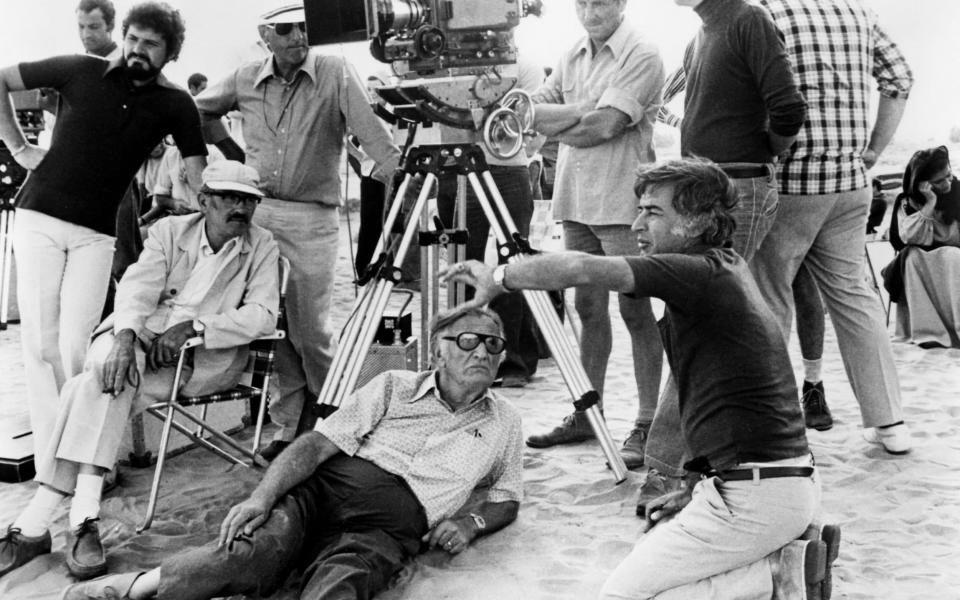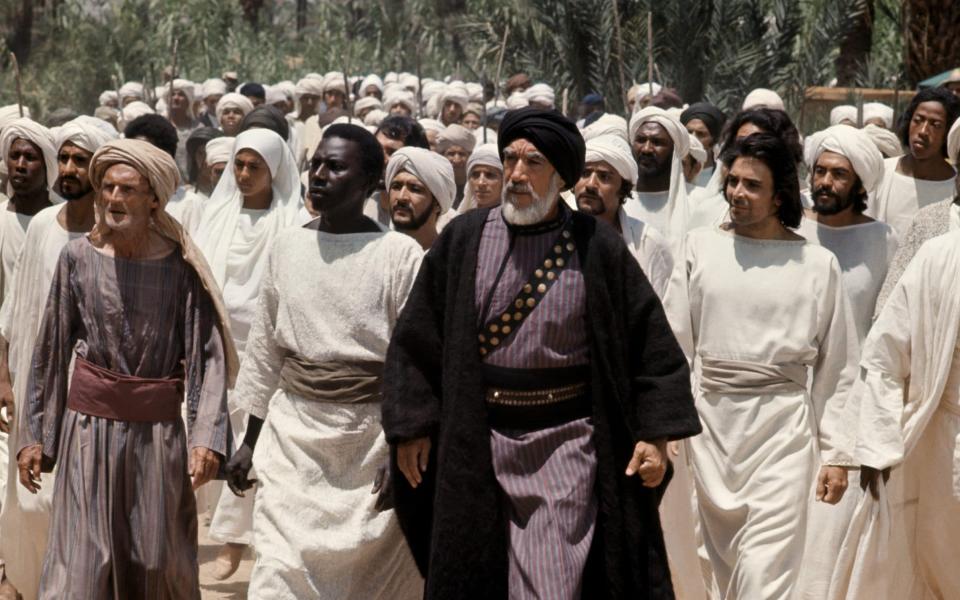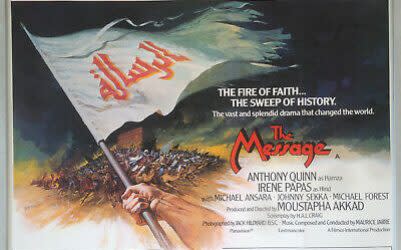The director who dared to make a film about the Prophet Mohammed

In July 1976, director-producer Moustapha Akkad was forced to change the name of his $17 million Islamic epic – from “Muhammad, Messenger of God” to simply “The Message” – just 72 hours before the London premiere.
As will be obvious to anyone who has been following the saga of Cineworld and the "blasphemous" Islamic epic The Lady of Heaven (or the last year's events at Batley Grammar School in Yorkshire) the change came after protests – including threatening phone calls to one cinema – from conservative Muslims who wrongly believed the film would depict the Prophet Mohammed.
But in The Message, the Syrian-born, American-trained Moustapha Akkad told the story of Mohammed and the birth of Islam without showing the Prophet.
“The Islamic religion forbids the portrayal of Mohammed,” Akkad told the Associated Press in 1976. “I solved that by having the camera act as the eyes of Mohammed. He is never seen, nor does he speak, but you feel his presence as the action swirls around him.”
The last-minute title change cost a reported $100,000, and followed months of wavering support and outrage from Muslim leaders and theologians. Tragically, it would not be the film's last controversy.
The Message was banned throughout the Arab world, and in March 1977 – as the film was set to open in the US – 12 Hanafi Muslim gunmen took 149 hostages in Washington DC.
Among their demands was that the film be banned. "We want the picture out of the country," the group's leader declared. "Because it's a fairy tale, it's a joke… I'm Muslim and I'll die for my faith. It's a joke. It's misrepresenting the Muslim faith." In a siege that lasted 39 hours, a young radio reporter was killed and dozens more were injured.
“When we made this film we really thought we were involved in a great event,” said lead actor Anthony Quinn. “I thought I was doing something worthwhile. I knew there were dangers. I knew I might be criticised. Here I thought I was doing a good deed, and it winds up like this.”
Moustapha Akkad – who was mentored by Sam Peckinpah and later produced the Halloween films – envisioned The Message as a tribute to the story of Islam, and to bring the story to Western audiences. “Being Muslim myself who lived in the West, I felt that it's my obligation, my duty, to tell the truth about Islam,” Akkad said in 1976. "I thought I should tell the story that will bring this bridge.”
He also said: “I think people in the Western word will be interested in learning about the Muslim religion. Nobody here knows that Islam believes in Christ, and Noah, and all the prophets, and the virginity of Mary.”
Actor Garrick Hagon – who played Ammar, one of Mohammed's most loyal companions – admitted his own ignorance. “At that time, we didn't know much about Islam,” he told NPR in 2016. “Mohammed was a name, and that was about all. So it was all pretty much of a revelation.”
The project first began in 1971. Akkad was inspired by Lawrence of Arabia – specifically, the majestic introduction of Omar Sharif, who rides towards Peter O’Toole from across the sands and through the rippling mirage.

The Messenger was imagined in the style of the biblical epics – a big budget Koranic epic to match the likes of Charlton Heston's The Ten Commandments. H.A.L. Craig – writer of Waterloo and Airport ’77 – was commissioned to write the screenplay. It was closely vetted for approval by Islamic scholars at the Al Azhar University in Cairo and the High Islamic Congress of the Shiat in Lebanon.
As if it wasn't ambitious enough already, Akkad decided to shoot two versions of the film – an English-language version with a Western cast, and an Arabic version with leading Muslim film stars. Respective scenes would be shot one after the other.
Speaking at the time, Akkad joked that Charlton Heston – the square-jawed hero of the day, and a regular in biblical blockbusters – shouldn’t get the lead role. But there was still controversy about Heston’s non-involvement: the Voice of America radio station mistakenly reported that Heston had been cast as the Prophet Mohammed, which ignited rioting in Muslim Pakistan.
The commanding Anthony Quinn was cast as Hamza, a sword-wielding warrior and the uncle of Mohammed. Quinn was a two-time Oscar winner and no stranger to the religious epic – he also played Barabbas in 1961. Quinn’s counterpart in the Arabic version of the film was Egyptian actor Abdullah Ghaith.
Also cast in the English version was Irene Papas as Hind, a Meccan woman who rejects Muhammad’s message, but later becomes Muslim; Damien Thomas as Zayd, Mohammed’s adopted son and follower; and Robert Brown – M in the James Bond series between 1983 and 1989 – as Utbah, a Quraysh antagonist who battles the Prophet’s followers.
As reported at the time, Mohammed Ali, who had converted to Islam 10 years earlier, harangued Akkad for the role of Bilal, a former slave and the first muezzin to call to prayer. But the role went to Johnny Sekka, a Gambian actor who had made the call to prayer at mosque as a child. “I approached it with great reverence, wanting to do the best possible job,” said Sekka in 1977. “I tried to ponder, ‘How was it done the first day when Bilal made the call?’”

His call to prayer is among the most powerful scenes in the film – a booming, emotional chorus that puts the other characters at a standstill.
Speaking in 1976, Akkad explained that he’d secured initial financing for the film from “sources in the United States, Kuwait, Saudi Arabia, Libya and Morroco”. There was resistance from the start. On his first trip to Libya to find money, Akkad was stopped at the airport and sent back on his way. Also, the king of Saudi Arabia, Faisal bin Abdulaziz Al Saud, refused him permission to shoot the film in Saudi.
Filming began in 1974, just outside of Marrakech, Morocco, where they built a replica of Mecca for a reported $700,000. The production included a 300-strong international crew (with 28 nationalities), crowds of 5,000 extras, two casts of 40 actors each, and herds of horses and camels.
Though Mohammed himself doesn't appear, the techniques still hold up. The Prophet’s presence is felt, almost eerily in places, but he's never seen or heard. Other characters repeat his words and address Mohammed by talking directly into the camera – a striking effect that strangely puts the viewer in the place of the Prophet. The camera becomes Mohammed's point of the view.
“I’ve never been involved in a picture in which everyone bent over backward as we did because of the delicateness of the situation,” Anthony Quinn told People Magazine. “The filming took a year, and we had six high priests with us constantly as advisers.”
The closest we get to Mohammed is seeing the head of his camel, as the Prophet leads his followers to Medina, or his staff. “I never intended to portray Mohammed, just as I wouldn’t portray Jesus or other religious leaders,” said Akkad. “Not because of any religious reasons. I simply don’t believe in it artistically.”
Indeed, there were a number of films about Christianity that treated the image of Jesus with similar reverence. In the 1939 film The Great Commandment, Jesus appears as a reflection, light, and voice; and like the Prophet in The Message, we see Jesus’s point of view. Other films, such as Quo Vadis, Ben-Hur, and Barabbas, featured only glimpses of Jesus (or just a limb), or brief cameo appearances. As recently as 2001, a short called The Cross followed The Message by shooting from Jesus’s POV.
As ingenious as Akkad’s approach was, he still faced problems from Muslim leaders. The king of Saudi Arabia put pressure on the Moroccan government, which ultimately expelled Akkad and his production from the country.
“There was an air of uncertainty on the set,” recalled Johnny Sekka in 1977. “We constantly heard rumours of a shutdown because many leaders of the Arab world were against the film. That situation was inflamed by reports in the West that Quinn was playing the Prophet.
“Akkad left the set one day to visit the king of Morocco. When he returned, he told us, ‘This film will be made. Nothing will stop us.’ But one day the soldiers arrived and production was shut down.”
The Message was rescued by an unlikely hero – Libya’s Colonel Muammar Gaddafi, who reportedly wept when he saw the footage that Akkad had already captured. Gaddafi allowed Akkad to relocate production near the desert town of Sebham, south of the Libyan capital Tripoli, and sent 3,000 troops to be used in battle scenes.
Speaking to NPR about Akkad's arrangement with Gaddafi – who later became America’s enemy number one – Akkad’s son, Malek Akkad, said, “My father was of one mind, that he was going to finish this film. And so where he could get assistance from, he did.”

The film took more than a year to make. Shooting the English and Arabic scenes together was laborious and costly. “I didn’t realise how much longer the Arabic version would take,” Akkad told the Associated Press. “The Arabic language is much more flowery, and the actors are more dramatic with their gestures.” During the post-production, Akkad was optimistic about the reception.
“There are 700 million Muslims in the world, and there is a great interest in the Middle East for the film,” he said. “There is also a curiosity about the title and the subject in the West. My picture won’t be a Jaws but I think it will be well received here. There seems to be a return to spirituality today, as the machine is taking over.”
But the Cairo scholars who had approved the script withdrew support and branded The Message “an insult to Islam”. Several countries – including Saudi Arabia, Kuwait, and Egypt – banned it. In London, the title change didn’t entirely solve the problem. When The Observer’s Russell Davies went to review The Message, there was a bomb scare at the screening. (“Three and a bit [hours] with intermission,” he wrote about the film’s lengthy runtime. “Three and a lot with bomb scare.”) The film was a reasonable success in Europe and Akkad eventually found a distributor for the US.
It was due to open on March 9, 1977. That day, fanatical gunmen took three buildings in Washington DC and held around 149 people. They had other demands, including the handover of men who had killed the family – including children – of their leader, Hamaas Abdul Khaalis.
The men weren't released, but the terrorists' other demand was met. The film was pulled in New York and Los Angeles - the projectors ground to a halt mid-screening - and reopened once the gunmen had surrendered.
It's doubtful that Khaalis actually watched The Message, but many who did liked it. Mohammed Ali praised Johnny Sekka’s performance. “Johnny you have made me so proud,” Ali told him. “I have seen Superfly and the other ways blacks have been depicted in films. I’ve never seen a role with such dignity.” The film’s score, by Maurice Jarre (who also composed the scores for Lawrence of Arabia and Dr Zhivago), was nominated for an Academy Award.
Tragically, Moustapha Akkad and his daughter, Rima Akkad Monla, were killed in a hotel bombing in Amman, Jordan in November 2005. Akkad was 75; Rima was 34.
Akkad did see The Message accepted by Muslim countries. Speaking in 1981, he described how the ban had been lifted.
“In the last two years The Message has been playing in Muslim countries,” he said. “It was just a matter of their seeing the film and realising it contained nothing offensive. Now it is playing everywhere in the Arab world.”

